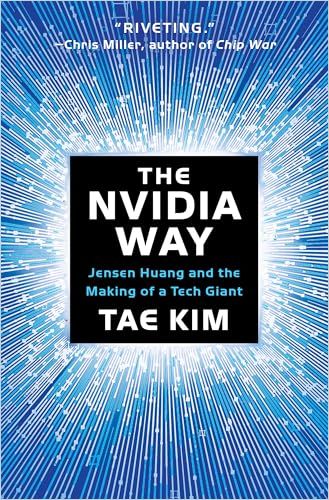Tae Kim, a senior writer for Barron’s, details Nvidia’s history, from its three-person startup to its dominance of the global chip market.

The Nvidia Saga
Barron‘s senior writer Tae Kim recounts how Nvidia began as a designer of graphics chips for video games and went on to become the dominant producer of AI systems chips – all under the same leadership trio, with a master CEO at the helm. Kim traces the company’s journey to becoming the dominant chip manufacturer in supporting AI developers.
Most valuable player
Nvidia has become the top producer of sophisticated processors for artificial intelligence (AI) systems — and the world’s most valuable company.
Nvidia’s founders Curtis Priem and Chris Malachowsky — who developed the GX chip at Sun Microsystems — and Jen-Hsun Huang launched the company on April 5, 1993. By June, Sequoia Capital and Sutter Hill Ventures had invested $1 million each. Priem became Nvidia’s chief technical officer; Malachowsky oversaw engineering and Jen-Hsun — known as “Jensen” — became CEO, an office he still holds.
Nvidia first developed the NV1 chip, a successor to the popular GX chip. In 1995, it agreed to develop the NV2 chip for a new console being developed by Sega, a Japanese video game producer. Sega rewrote games to run on the NV1 chip and paid $5 million for preferred Nvidia stock.
The NV1 didn’t work well with Sega’s games, especially DOOM, then the world’s most popular game. It slowed the player experience and degraded the game’s audio. In 1996, Sega told Nvidia it wouldn’t use the NV2 in its next console. Reeling from that news, Nvidia cut its 100-person staff to 40.
When we were younger…we sucked at a lot of things. Nvidia wasn’t a great company on day one. We made it great over 31 years…we survived ourselves. We were our own worst enemy. Jen-Hsun Huang
Also in 1996, three former employees of Silicon Graphics (SGI) — which made workstations for computer-generated cinematic special effects such as the dinosaurs in Jurassic Park — developed a rival chip, the 3dfx. Its sales soared from $4 million in FY1996 to $203 million in FY1998.
Nvidia entered the fray with the NV3 chip, featuring a 128-bit memory bus, the largest ever on one chip. To build it, Nvidia bought a $1 million Ikos chip-emulation machine. At the time, the company had only enough cash to cover its payroll for nine months.
Nvidia called its new chip the RIVA 128 – for Real-Time Interactive Video and Animation Accelerator – and introduced it in 1997. Nvidia shipped a million RIVA 128 units in its first four months, capturing 20% of the PC graphics market. In 1997, PC Computing magazine recognized the RIVA 128 as the “Product of the Year.”
Making a profit
Thanks to the RIVA 128, the company racked up its first quarterly profit in the fourth quarter of 1997.
Nvidia outsourced the manufacturing of the graphic chips it designed. After releasing RIVA 128, the company turned to Taiwan Semiconductor Manufacturing Company (TSMC) as its primary supplier. However, production problems led to faulty chips that were indistinguishable from TSMC’s functional chips.
Nvidia’s extreme work culture stems from the chief executive himself, who lives and breathes his job and looks down on anyone who isn’t as committed.Tae Kim
In mid-1998, Nvidia CFO Geoff Ribar said the company was within weeks of insolvency. Then Jensen secured $11 million in financing from its three largest customers.
Meanwhile, 3dfx (whose managers once had considered trying to acquire Nvidia) found itself weakened by unfocused marketing and product development — plus its expensive acquisition of a major graphic board manufacturer in 1998. Two years later, Nvidia hired about 100 of 3dfx’s employees and acquired its patents. In October 2002, 3dfx declared bankruptcy.
Nvidia’s GPU and CUDA
Nvidia’s IPO on January 22, 1999, raised $42 million. The stock closed at $19.69, valuing the company at $626 million.
In January 2000, Microsoft paid Nvidia $200 million to develop a new Xbox chip and Nvidia’s stock price jumped to more than $100.In 2001, Nvidia launched the GeForce 3 chip, pushing the company’s annualized revenue to $1 billion in the third quarter of 2000.
By 2002, computer scientists were increasingly using GeForce 3 for tasks unrelated to graphics. In 2006, Nvidia introduced its Compute Unified Device Architecture (CUDA), enabling engineers and scientists to harness the power of GPUs. CUDA utilized the G80 chip, the first GeForce graphics card that performed computational tasks. Nvidia spent $475 million developing the G80 as a GPU computing chip, and also spent heavily to make its GPUs compatible with CUDA.
Nvidia urged universities to adopt its GPUs, offering them computers with CUDA-compatible GPUs in exchange for teaching CUDA programming classes.
Nvidia has shipped about 500 million GPUs that are compatible with CUDA. Its heavy investment in device architecture and general-purpose GPUs paid off when AI surged at the start of the 2020s. Nvidia’s platform enabled companies that create AI applications to develop them quickly with few technical problems. CUDA is a “foundational ecosystem” for AI developers, and Nvidia makes the only chips that run on the platform.
Back in 1980, Bell Labs employee Bill Dally worked on developing some of the first microprocessors, or chips. He wrote his PhD dissertation on “concurrent data structure,” a technique for structuring data so that a computer can use it for multiple simultaneous tasks. Nvidia relies on this parallel computing technique. Dally became the chair of the computer science department at Stanford University and then left academia to join Nvidia’s team developing GPU technology.
AI chips
Nvidia established its first software library for AI, the CUDA Deep Neural Network, a popular tool among AI developers. In 2006, the company created Nvidia Research to explore innovations that might not become marketable products for years, if ever.
At Nvidia, the whiteboard is more than the primary form of communication at meetings. It represents both possibility and ephemerality – the belief that a successful idea, no matter how brilliant, must eventually be erased, and a new one must take its place.Tae Kim
Amazon, Microsoft, and other big tech companies are developing chips for AI applications even as AI developers are bringing more innovations – such as ChatGBT – to market. Nvidia remains the sole independent producer of graphics chips, and, in 2024, bypassed Microsoft as the most valuable company in the world, with a market capitalization of $3.3 trillion.”
Review
Former Bloomberg opinion columnist Tae Kim, now a senior writer for Barron’s, offers a tale of corporate growth for investors and details the evolution of Nvidia’s advanced chips for techies. Kim’s extensively researched, well-paced corporate profile also provides a management master class in its portrayal of iconoclastic CEO Jen-Hsun “Jensen” Huang. Nvidia’s saga is unique, featuring astounding early highs and disheartening mid-life near-collapses. Kim keeps Jensen on center stage, depicting the company’s decades-long saga mostly through his eyes. Jensen proves a compelling star. Nvidia’s dominance seems to be his doing and derives from his indefatigable, inspiring work ethic. (Note, however, that the book was published before the debut of China’s competitive DeepSeek chip.) Kim’s corporate history is a compelling page-turner, and you don’t have to work in Silicon Valley to be enthralled.
.












